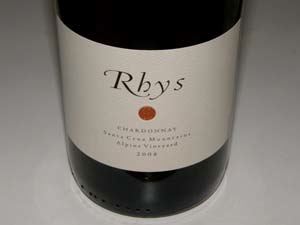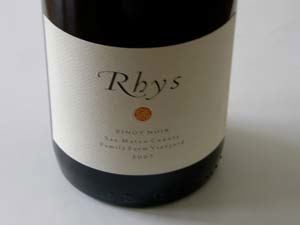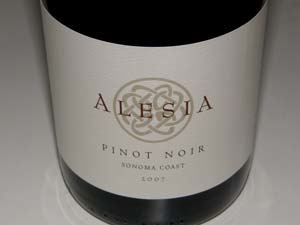Rhys Vineyards: Three Vintage Tasting
Rhys Vineyards has caused quite a buzz among the pinoiriste community for its innovative viticulture and
terroir-driven wines from the Santa Cruz Mountains. Rhys farms five estate vineyards scattered through the
Skyline subregion of the Santa Cruz Mountains, all within a 25-minute drive of each other, and a single estate
vineyard in Anderson Valley. It is said that Pinot Noir thrives on the edge and these vineyards represent
special challenges to successful winegrowing. The cost of developing the vineyards has been substantial and
it has taken several years to learn the vagaries of each vineyard site, and the appropriate mix of Pinot Noir
selections and clones best suited to each microclimate.
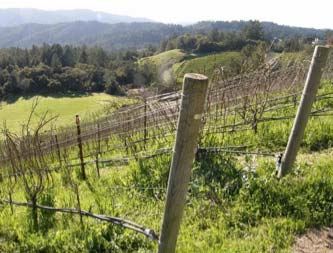
The model at Rhys is clearly Burgundian and more specifically, the Domaines of DRC and Dujac. Several of
the vineyards are planted to close spacing using a variety of Dijon and California heritage clones, duplicating
the clonal diversity approach in Burgundy. Significant whole cluster fermentation is the rule, making these
wines less appealing on release, much like their Burgundy brethren. Meticulous farming allows grapes to be
picked early yet possess phenolic ripeness, so that alcohols are under 14.0% and sometimes astonishingly low
(under 13.0%). There is no compromise in vinification that would lead to early consumer-friendly drink-ability.
A new underground winery was completed in time for the 2010 harvest. Grapes enter the cave entrance and
the finished wines exit through another opening in the cave. This is a showpiece winery in the Santa Cruz
Mountains, bringing much-needed prestige and notoriety to this often unheralded region.
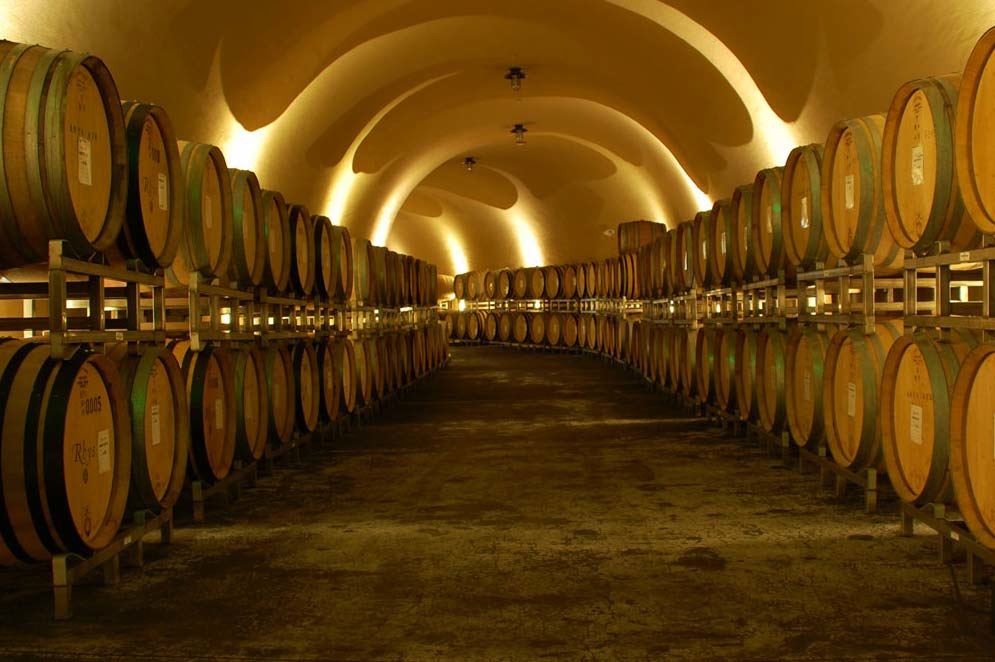
Proprietor Kevin Harvey conferred the name Rhys Vineyards on his project, using a family name which is the
Welsh spelling of Reese. He planted his Home Vineyard in 1995 and four additional vineyards (Family Farm,
Alpine Road, Horseshoe Ranch and Skyline) between 2001 and 2005. The Family Farm Vineyard and Home
Vineyard are located about 200 feet below the demarcation of the official Santa Cruz Mountains AVA, so they
are not strictly in the AVA, and the wines from these two vineyards are labeled San Mateo County. Despite this
incongruity, the wines from these two vineyards are Santa Cruz Mountains in character. A sixth vineyard,
named Bearwallow, is a 20-acre site in the cool, “deep” end of the Anderson Valley, with 7 acres of established
Pinot Noir vines. Additional planting is scheduled along with refurbishment of the existing vineyard. The first
vintage from this vineyard was 2008. The first Santa Cruz Mountains estate wines were released in 2004.
Winemaker Jeff Brinkman (below) is bright and talented, having majored in biochemistry in college and learned
winemaking on the job, beginning as a cellar rat in 1996. Javier Tapia Meza is the viticulturist. Farming is
strictly organic with biodynamic influences.
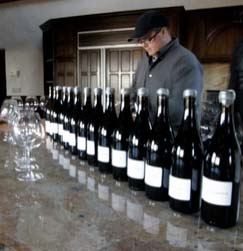
The winemaking regimen for the estate Pinot Noirs is as follows. The grapes undergo a 10 to 14 day cold soak
under reductive conditions. The cooling jackets are then shut off and natural fermentation ensues. The cap is
punched down three times a day by foot treading, a method chosen for its gentleness. Fermentation lasts
about 3 weeks. The ferment is pressed off with a basket press and the juice gravity fed into barrel. MLF is
allowed to continue on its own. Blending takes place either before or after the next harvest after the wine
spends approximately 14 months in barrel. All barrels are sourced from Francois Frères and are crafted from
4-year air-dried staves to insure there is no barrel variability. The percentage of new oak varies from 25% to
75% depending on a number of factors. The estate wines are all unfined and unfiltered.
I recently tasted through both Alesia (Rhys Vineyards wines from declassified or purchased grapes) and Rhys
Vineyards wines from the 2006, 2007, and 2008 vintages. Not every wine produced was sampled as many
have only come into full production recently and were either offered in minuscule amounts or not available at all
to me. I have tasted all three vintages at the winery and my notes are in previous issues of the PinotFile
(www.princeofpinot.com/article/795/, www.princeofpinot.com/article/633/).
Rhys Vineyards wines are highly allocated and available only through the winery’s mailing list. More wine
should become available as the vineyards mature and replanting brings vines on line. The winery is not
currently open for tasting or tours. Visit the informative website at www.rhysvineyards.com.
2008 Rhys Vineyards Family Farm Vineyard Santa Cruz Mountains Pinot Noir
12.6% alc., $49. Swan
selection, Pommard clone, and Dijon 115 clone planted to 6’ x 6’ at 400 feet on clay loam soil. Yield 2.6 tons
per acre.
·
Moderate reddish-purple color in the glass. Demure but pleasing scents of Bing cherries and
cardamom spice with hints of minty oak and stem. Relatively delicate flavors of cherries, raspberries and red
hard candy with a bright citrus peel note. Delivers more intensity with time in the glass but doesn’t excite. The
nose trumps the flavors at this time. More akin to a Russian River Valley Pinot Noir. About the same the next
day from a previously opened and re-corked bottle. May improve with cellaring. Good.

2008 Rhys Vineyards Alpine Vineyard Santa Cruz Mountains Chardonnay
13.3% alc., $59. Hyde and Wente selections, 76 and 96
clones planted to 6’ x 4’ at 1380 feet on soils with top soil over soft shale.
Yield of 1.8 tons per acre.
·
Moderately light golden yellow color. Lovely
perfume of lemon curd, white stone fruits and stewed apples. Delicious
and layered, with notes of green apple, pears, brioche and toast. The
wine has a bright steeliness due to the lively acidity. A beautiful wine that packs
in plenty of flavor at modest alcohol: a win-win situation. Will age.

2008 Rhys Vineyards Alpine Vineyard Santa Cruz Mountains Pinot Noir
13.3% alc., $59. Heritage and suitcase selections planted to 6’ x
4’ at 1230 feet on soils with top soil over soft shale. Yields 1.04 tons per
acre.
·
Moderately intense reddish-purple color in the glass. Intense and
intoxicating perfume of purple fruits, dried roses, and whole-cluster
induced spiciness. A bit reticent, but offering a glimpse of intense plum
and dark berry fruits that saturate the palate without being weighty, persisting on
the intensely fruity finish that is highlighted by exotic spices and edible flowers.
Nothing out of place. Much more open and giving two days later from a
previously opened and re-corked bottle. Still a Lolita with huge potential.
2007 Alesia Sonoma Coast Pinot Noir
14.1% alc., $35.
·
Nicely perfumed with
raspberries, cherries and spice box. Tasty essence of red fruits including red
plums, cherries and pomegranates with supple tannins and lively acidity
contributing a tangy finish. A typical Caliesque wine with in-your-face fruit that
will find fans. Good.
2007 Rhys Vineyards Alpine Vineyard Santa Cruz Mountains Pinot Noir
14.0% alc., $49.
·
Moderately dark
reddish-purple color in the glass. Enticing aromas of black cherries, black raspberries, spice and vanillin.
Richly fruited with dense but crisp flavors of ripe dark fruits nicely spiced, mineral-imbued, and caressed by
structured tannins. A silky and seductive wine that has charm. Unchanged one and two days later from a
previously opened and re-corked bottle. Very good.

2007 Rhys Vineyards Family Farm Vineyard San Mateo County Pinot Noir
13.4% alc., $49. Swan selection, Pommard clone, Dijon 115
clone planted on alluvial clay loam. Yield of 2.1 tons per acre. Aged in
40% new French oak barrels.
·
Moderate garnet color in the glass. Great
nose with flamboyant scents of black cherry compote, raspberry jam,
clove and other spices, and a hint of smoke. Dark red fruited with
intense and vivid red plum and berry flavors framed by exotic spices. The
tannins are firm and dry, the mouth feel is silky, and the balance is spot on. A
beautiful, black tie Pinot Noir that demands attention.
2007 Rhys Vineyards Home Vineyard San Mateo County Pinot Noir
13.3% alc., $59. A field blend of .25
acres planted to 5’ x 6’ on decomposed sandstone. Yields of 2.5 tons per acre. Aged in 100% new French oak
barrels.
·
Deep, dark reddish-purple color in the glass. Very ripe fruit aromas of black cherries, raisins, grilled
fruit, leather and exotic spices. Moderately dense and thick dark berry and black cherry fruit with an earthy
undertone and a hint of anise, all wrapped in restrained, firm tannins. Big-boned but soft on the palate,
becoming smoother and more delightful with time in the glass. Very good.
2006 Alesia Chileno Valley Sonoma Coast Pinot Noir
14.0% alc., $29.
·
Moderately deep reddish-purple
color in the glass. Aromas of cherries, red punch, green oak and underbrush. Slightly sweet cherry and
strawberry flavors with hi-tone acidity and oak in the background. Drink up. Decent.
2006 Alesia San Mateo County Pinot Noir
13.8% alc., $29. Declassified fruit from the Family Farm
Vineyard.
·
Moderate reddish-purple color in the glass. Slightly cooked cherry aromas with notes of polished
wood, spice and cut flowers. Crisp and bright, with delicate and tasty strawberry and black cherry flavors with
a sidecar of anise and toast. Silky with bright acidity and a thin, short finish. Drink up. Decent.
2006 Alesia Sonoma Coast Pinot Noir
14.1% alc., $35.
·
A well-endowed wine with upfront aromas and
flavors of rich dark fruits including plum blackberry and cassis with supporting toasty oak. A fruit-driven wine
with soft tannins and almost liquor-like dense fruit. Good.

2006 Rhys Vineyards Alpine Hillside Santa Cruz Mountains Pinot Noir
13.9% alc., $49. Sourced
from the steepest and lowest yielding section of Alpine Vineyard (see photo above).
·
Deeply colored.
Muted aromas of dark fruits with a very appealing hint of exotic spices. Luscious broad-shouldered
fruit core with impressive intensity, backed by firm tannins and offering an amazing persistence on the
glorious finish. Similar in flavor to the regular Alpine Vineyard bottling but ramped up a notch. Drinking
great two days later from a previously opened and re-corked bottle. An impressive effort that should
continue to evolve in years to come.






